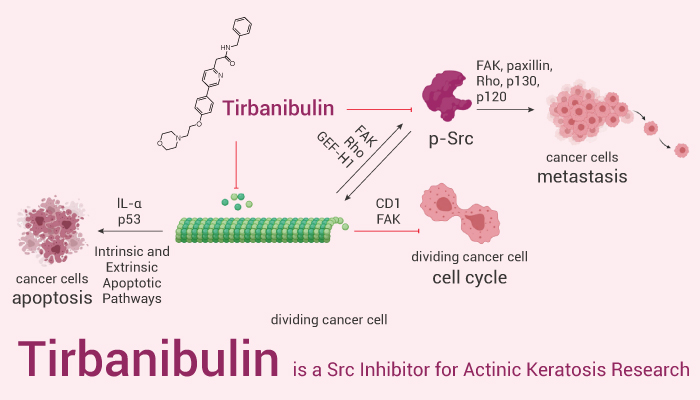The SRC kinase family is a family of non-receptor tyrosine kinases, in which Src kinase belongs to the SrcA subfamily and is unique to vertebrates. Src kinase transduction is associated with processes of cell proliferation, differentiation, motility, and adhesion. Src kinase activation leads to an increase in these processes and may trigger the development of human cancer. Inhibition of Src kinase is often a target or target of anticancer drugs. Here we introduce Tirbanibulin, a non-ATP competitive inhibitor of SRC kinase and tubulin polymerization. It is designed to target the substrate binding pocket of Src. It has a broader spectrum of activity and better potency than the competitive adenosine triphosphate (ATP) inhibitor Dasatinib.
Tirbanibulin (KX2-391) is an Src inhibitor that targets the peptide substrate site of Src.
Tirbanibulin shows steep dose-response curves against four HCC cell lines: Huh7 (GI50=9 nM), PLC/PRF/5 (GI50=13 nM), Hep3B (GI50=26 nM), and HepG2 (GI50=60 nM). It also inhibits tubulin polymerization and has anti-HBV activity. It inhibits HBV replication in a dose-dependent manner and exhibits antiproliferative and antitumor effects. The expression of factors such as hepatocyte nuclear factor 4a is also reduced during the inhibition process. Actinic keratosis (AK) is a common preneoplastic skin lesion consisting of uncontrolled proliferation of atypical keratinocytes that may progress to squamous cell carcinoma. Tirbanibulin is a potent inhibitor of AK.
In preclinical animal models of cancer, oral administration of Tirbanibulin inhibits primary tumor growth and inhibited metastasis. Tirbanibulin also has inhibitory effects on drug-resistant leukemia cells, such as chronic leukemia cells with the T3151 mutation.
In summary, Tirbanibulin is a Src kinase inhibitor and tubulin polymerization inhibitor with potent anti-tumor potential.
References:
[1]. Lau GM, et al. Dig Dis Sci, 2009, 54(7), 1465-1474.
[2]. Fallah-Tafti A, et al. Eur J Med Chem, 2011, 46(10), 4853-4858.
[3] Harada K, et al. Antiviral Res. 2017 Aug;144:138-146.
